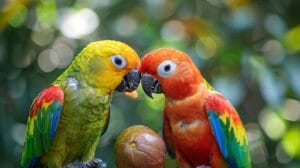TL;DR – What You Actually Need to Know
- DALL-E is an AI tool that creates images from text prompts. You describe what you want, and it draws it—for better or worse.
- You don’t need design skills. You just need to write clear prompts.
- DALL-E 3 is built into ChatGPT (Pro), making it simpler.
- You can revise specific parts of an image using a feature called inpainting.
- Results vary, but it’s free to try and works best with a paid ChatGPT plan.
About DALL-E
DALL-E is a tool that turns text into images. You type in a description like “a dog wearing sunglasses sitting at a podcast mic,” and it creates a visual version of that idea.
Sometimes, it’s spot on. Sometimes, it gives you a dog with too many teeth. Either way, it’s fast.
Created by OpenAI (the same team behind ChatGPT), DALL-E lets anyone generate original art, graphics, or illustrations just by describing them.
For solo business owners, it’s a shortcut. You can generate:
- Visual metaphors for your content
- Original thumbnails or social images
- Slide illustrations for workshops or webinars
- Concept images for clients or courses
You’re not replacing designers. You’re just getting a quick visual when maybe hiring one doesn’t make sense.
What is it?
The name is a portmanteau (mashup) of “Dalí” (the surrealist painter) and “WALL-E” (the Pixar robot.) That pretty much sums it up: AI that makes strange, smart, or sometimes oddly broken art.
DALL-E is trained on millions of images and captions.
It learned how words connect to visuals and how to guess what something should look like based on your prompts – then generates them from scratch using what it’s learned about style, color, and composition.
Different versions
DALL-E 2 was good at generating images but struggled with details like hands, text, and anything that required spatial logic.
Insert stock Image: Side-by-side comparison of a bad AI-generated hand vs. a good on.
Caption: “DALL-E 3 still isn’t perfect, but your characters are less likely to have six fingers.”
DALL-E 3 creates more accurate images, follows prompts better, and is built into ChatGPT for easier access.
The jump from version 2 to 3 also added:
- Better rendering of complex scenes
- Ability to generate text within images (signs, posters, etc.)
- Integration with prompt-writing tools, so you don’t have to guess how to ask for what you want.
DALL-E 3 understands your request more precisely, which makes it easier to use even if you failed high school art and don’t speak “designer.”
What Can DALL-E Do?
DALL-E creates images and gives you control over what those images look like.
You just need a clear idea of what you want to see.
Image generation gapabilities
- You write a prompt.
- DALL-E creates a visual version of that idea.
- That’s the basic loop.
It handles everything from simple icons to full illustrations.
Some examples are:
- “A minimalist icon of a coffee cup with a lightning bolt on it.”
- “An abstract background with soft pastel shapes for a coaching website”
You can describe the vibe, style, color, and level of realism because it understands basic art styles like “line drawing” or “digital painting.” You can also tell it what not to include, like “no people or text.”
Customize your output
You can generate more options if you don’t like what you get the first time.
- Ask for variations
- Change parts of your prompt.
- Use inpainting to edit just one section of the image (more on that in a minute)
You don’t have to start over every time. You can refine instead of redoing, which makes it easier to get something usable without fighting the tool.
DALL-E isn’t perfect, but it’s flexible.
DALL-E 2 vs. DALL-E 3
DALL-E 3 is the version built directly into ChatGPT.
Integration with ChatGPT
With DALL-E 3, you don’t need to write perfect prompts. ChatGPT helps you shape them. You can say:
ChatGPT will turn that into a more structured prompt. You just describe the idea, and the system does the translation.
You can also refine the image by saying things like:
- “Make it less busy.”
- “Change the color scheme to earth tones.”
- “Add more white space”
You type. It listens. You adjust. It redraws.
How to Access DALL-E
DALL-E 3 lives inside ChatGPT, but only for users on the paid plan. If you already have ChatGPT Plus, you’re good to go.
To get to it:
- Log into chat.openai.com.
- Make sure you’ve selected GPT-4.
- Type your prompt directly in the chat window.
Once you hit enter, ChatGPT will return an image based on your description. You’ll see a small preview, which you can expand or download. You can ask for changes, and it will regenerate or revise.
There’s also a standalone image editor inside ChatGPT, where you can make changes using inpainting. You’ll see a small pencil icon or an “edit image” option under the result.
Using DALL-E
DALL-E is only as good as the prompt you give it. Vague inputs get vague results. If you want a clean, specific image, you need to describe it clearly.
Importance of prompt specificity
If you say: “Draw a happy person.”
You might get anything from a cartoon child with balloons to a watercolor monk meditating in the mountains.
Insert stock image: Close-up of a laptop or monitor showing a text field with a long, specific prompt being typed.
Instead, try:
That prompt gives the system enough direction to produce something useful the first time.
For better results
Keep your prompts clear and concrete. Say what you want, what style you want it in, and what to avoid.
Use phrases like “flat design,” “realistic photo,” or “pastel illustration” to guide the aesthetic.
You don’t need to write like a designer. You just need to write like someone who knows what they’re looking for.
DALL-E Tips & Tricks
DALL-E works well out of the box, but a few small habits make it more useful and less frustrating.
🟨 Start with what you need – Don’t overcomplicate your first prompt. Focus on the goal and build from there.
🟨 Avoid asking for perfect text in images – It struggles with long, readable text. If you need clean labels or headlines, leave space and add the text manually.
🟨 Use ChatGPT to help with your prompts – Say what you want in plain English, then ask it to turn that into a better prompt for DALL-E. It’s surprisingly effective.
🟨 Name and organize your images – If you’re creating visuals for multiple pages or clients, save your image files with clear names. It’s easy to lose track when generating lots of options quickly.
DALL-E gets better with practice.
DALL-E Use Cases
DALL-E sounds like a novelty tool until you start using it for real projects. It’s useful for fast ideas, quick visuals, and filling design gaps where hiring someone isn’t realistic.
Art and design
For example, coaches and consultants could use it for:
- Blog post thumbnails
- Slide illustrations
- Branded quote graphics
- Workshop handouts
You can also create visual metaphors – like “a tangled ball of string slowly unraveling” to represent abstract ideas in client work or teaching.
It helps you move from idea to visual without opening a design app.
Integration in Different Industries
Beyond coaching, DALL-E is used in:
- Marketing – To generate concept visuals and ad mockups
- Education – To illustrate lesson materials and course content
- Product design – To test out visual ideas before hiring designers
- Publishing – For placeholder art or small-run digital zines
It’s about getting a good-enough visual fast, especially when your time or budget is tight.
DALL-E Cost
You can try DALL-E for free, but the full version lives in ChatGPT Plus.
Pricing models for DALL-E
DALL-E 3 is bundled with ChatGPT Plus, which costs $20/month. That gets you access to:
- GPT-4 (text and image generation)
- DALL-E 3, including editing tools like inpainting
- Other tools like the PDF reader and file uploads
There’s no separate fee just for DALL-E. If you already use ChatGPT Plus for writing or planning, DALL-E is part of the package.
Restrictions and Limitations
There are limits on what DALL-E can generate, and some of those limits are intentional.
OpenAI blocks certain prompts, which include anything violent, sexually explicit, or politically sensitive. It also avoids creating realistic images of real people.
Content guidelines
OpenAI blocks certain prompts by default. That includes anything violent, sexually explicit, or politically sensitive. It also avoids creating realistic images of real people.
It’s not always perfect, but the boundaries are there to reduce misuse.
Technical limitations
DALL-E still struggles with:
- Hands, faces, and small details (it’s improved in version 3)
- Long or readable text inside images
- Very specific layouts or branding
- Consistency across multiple images
You may still need to hand off rough drafts to a designer or fix details manually in an editing tool.
Use DALL-E for speed, brainstorming, or filler but not as a substitute for creative professionals.
Copyright and ownership
The images you create in DALL-E are yours to use. OpenAI’s terms give you the right to publish, modify, and distribute them.
However, you should avoid using prompts that ask for replicas of existing artists’ styles or copyrighted work.
Impact on real artists
DALL-E won’t replace great designers. It just creates decent visual output quickly. Still, some artists are right to question how their work was used to train the system.
If you have the budget, it’s worth hiring humans.
Use DALL-E for speed, brainstorming, or filler but not as a substitute for creative professionals.
What’s Next
DALL-E makes visual content more accessible. You just need a clear idea and a sentence or two.
Used well, it can give you quick images for your site, deck, course, or client work. Used poorly, it’ll give you melted eyes and misshapen hands.
Either way, it’s a powerful tool worth adding to your stack, especially if you already use ChatGPT.
Want to learn more ways to use AI in your work? Subscribe or join as a member. We share tools, prompts, and clear answers for people who don’t have time for fluff.



